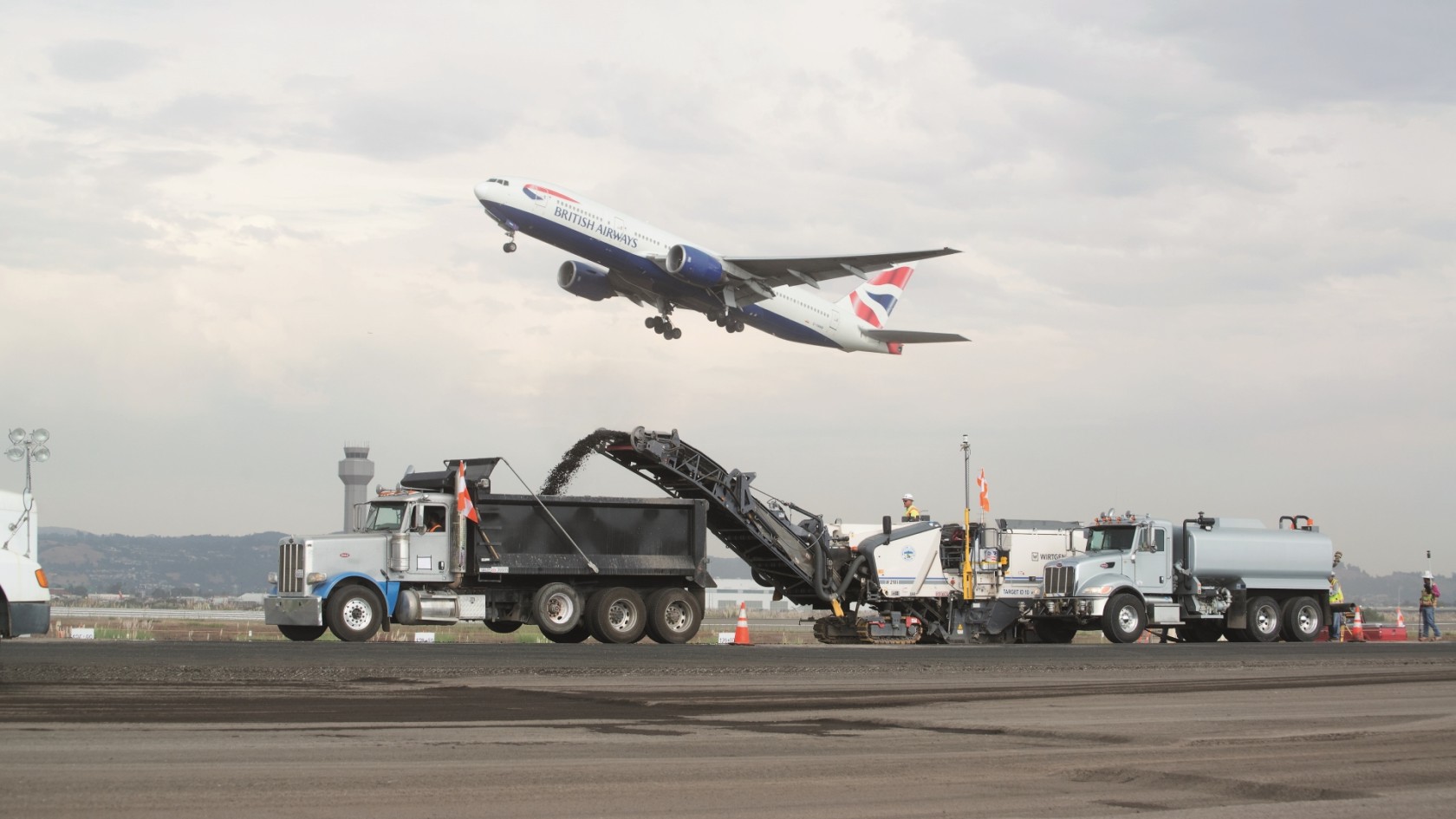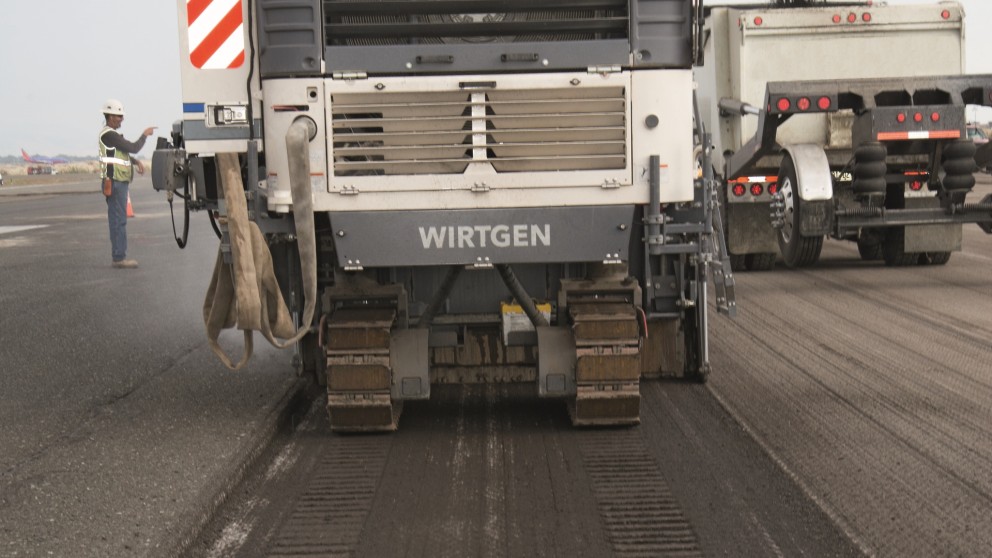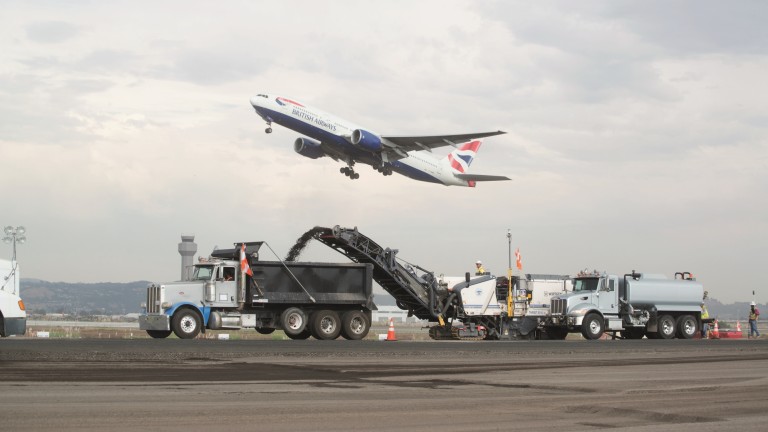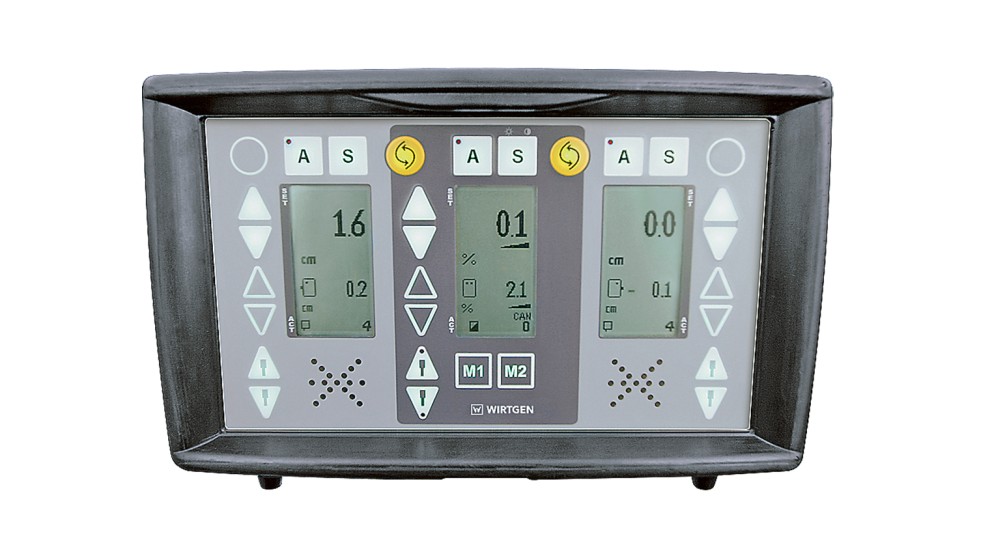

Challenging milling depths
A fleet of six W 210i cold milling machines from Wirtgen removed tens of thousands of tons of aged asphalt in less than 60 hours from a runway at Oakland International Airport in California – although the milling depths varied constantly.
Milling subcontractor Pavement Recycling Systems, Inc. cut a veritable mountain of reclaimed asphalt pavement (RAP) from Runway 12-30 along the shore of San Francisco Bay. In total, 47,000 tons of asphalt were milled within a 60-hour time frame, nonstop day and night, plus a single-shift second phase a week later. “We started milling at 6 a.m. Monday and we worked 12-hour shifts nonstop until about 3:30 p.m. Wednesday,” said Kurt Eddy, Operations Manager for Milling and Restructuring, for Pavement Recycling Systems, Inc. Immediately after, the prime contractor DeSilva Gates Construction began paving.
The short time slot was driven by substantial liquidated damages of over $700,000 per day, payable if the general contractor failed to open the runway on time. “DeSilva Gates made the deadline and they killed it,” Eddy said. “Everything we needed to support our operation was provided by them, and then some.” All raw, 3.5-in.-minus RAP was kept on the airport property and used to correct elevations of taxiways, building up a levee along the bay shoreline, as well as for other construction purposes. The cold milling machines, equipped with the optional wider milling drum, cut at a width of 7 ft., 3 in., according to Terry Graves, Superintendent for PRS. The challenge was not the width of the passes, but the varying milling depths.

By removing the asphalt fast and efficiently, the W 210i produced an even base which is true to line and level.
“We all had extremely tight time constraints,” Eddy said. “We chose the W 210i due to our experience with this model. It has been a durable and dependable machine for us. The enormity of this project required us to use a machine we trust, and the W 210i cold milling machines have been great for us.”
The two-meter cold milling machine is suitable for demanding milling jobs thanks to its high efficiency and versatility. The tried and tested professional machine offers a wide range of applications including surface course rehabilitation, complete pavement removal and fine milling jobs. The ergonomically designed, walk-through operator’s platform and the intuitive operating concept support high daily production rates.
With the innovative FCS Light, various milling drums and milling units with working widths of 4 ft. 11 in., 6 ft. 7 in. and 7 ft. 3 in. can be implemented to achieve higher levels of flexibility and machine performance. Three adjustable milling drum rotation speeds allow for high milling outputs under changing demands

With the W 210i, three selectable engine speeds enable complete pavement removal at a full depth of 13 in. However, at OAK, the milling depths varied constantly. “Cutting to the digital models, and staying within the confines of all the different models, was one of the biggest challenges of this job,” Eddy said. To achieve optimum milling results, Wirtgen cold milling machines offer state-of-the-art features. These include one of Wirtgen’s core technologies – leveling. When the surface course is removed, the LEVEL PRO leveling system continually compares the actual milling depth with the preset target milling depth. LEVEL PRO can work with different sensors – cable, hydraulic cylinder, sonic and slope sensors or laser and sonic ski sensors as well as multiplex systems – and can be extended as required. 3D leveling is also possible with installed interfaces that are compatible with 3D systems from common manufacturers.
So the total station system interfaced seamlessly with Wirtgen’s LEVEL PRO system, which converted the signal to Wirtgen’s ’language’ and “made the appropriate grade changes based on the currently required elevation,” Eddy said. Accuracy of milling was within hundredths of a foot. “The speed and the depth varied so much, as we went from cutting zero in some areas, to 11 in. in other areas, depending on what the digital models required,” added Graves. In fact, there were five different models for the W 210i cold milling machines to work with. “There were benches of pavement remaining everywhere, at all different sizes, shapes and depths,” explained Eddy. “Areas of distressed pavement were identified prior to the milling operation, and they were built into the digital models,” Graves continued. “There was a minimum requirement of asphalt to be removed for each. The asphalt was to be milled out at 3 in. increments, so if we had to cut 8 in. we had to go 9 in. deep.”

With the Wirtgen Flexible Cutting System (FCS) Light, various milling drums and milling units with working widths of 4 ft. 11 in., 6 ft. 7 in. and 7 ft. 3 in. can be implemented to achieve higher levels of flexibility and machine performance.
The changes in models were marked using limit lines on the runway surface. “Whenever we came up to another line painted on the pavement, it would have a model number which we’d have to change in the settings,” Eddy said. Essentially, PRS would mill at one depth to a limit line; stop and change the parameters that they were working with to get to the new depth prescribed; then proceed to the next line, where the setting would have to be changed once again. “We would work in a lineal fashion, and from left to right, within the confines of the models in order to cut the proper areas the way they wanted,” Eddy said.
“String lines were painted all over the runway to identify the different tasks. We could not just start at one side of the runway and go across laterally. Instead, areas were specified for the models. If you overlapped one, you would run into the next. The problem with overlapping was that if you wandered off the area, you would be off-model and essentially off-grade. Therefore, it was imperative that we milled within the confines of each painted outline.”
“Due to the variable cutting depths that were required, we weren’t able to just go in and operate at 100% load all the time,” Eddy said. “Otherwise our timeline would have been a lot shorter for pulling the tonnage out that we did.” Wirtgen’s advanced Parallel- to-Surface technology (PTS) – which automatically keeps the cutter housing level as the W 210i moves into a cut – accelerated production. “We set-in hundreds of times out on the airfield and used it on every machine, over and over, to cater to the multiple depths the job involved,” Eddy said. “The operators love the W 210i. From their standpoint, it’s the preferred machine in the company to run. It was the right fleet of machines for this project and they performed excellently.”

Kurt Eddy, Operations Manager for Milling and Restructuring Pavement Recycling Systems, Inc.
PRS has great confidence in its Wirtgen cold milling machines. “Our experience has been that they are top-notch machines,” Eddy said. “They are extremely dependable and productive. They are the most technologically advanced machines out there, and were capable of working with the automatic machine guidance systems that we are required to use. The majority of our fleet is Wirtgen, including our cold milling machines as well as our recyclers / reclaimers. The fact that we had zero breakdowns, and the machines performed the way we expected them to, took downtime out of the equation.”
Overall, the LEVEL PRO system comprises the clearly structured LEVEL PRO panel, a controller and multiple sensors. The LEVEL PRO panel provides a clear readout of key parameters. An additional milling depth indicator on the screen – showing the difference between scraper blade and side plate positions – enables convenient monitoring of the actual milling depth. In addition, the memory feature is extremely useful to pre-program, store and retrieve set values. When the automatic leveling system is activated, the machine is lowered automatically at maximum speed together with the rotating milling drum. Once the side plates reach the ground, the lifting columns continue lowering in slow mode; the lowering rate is adjusted further in the milled cut, if required.

Wirtgen’s LEVEL PRO comprises the clearly structured LEVEL PRO panel, a controller and multiple sensors. The LEVEL PRO panel provides a clear readout of key parameters. An additional milling depth indicator on the screen – showing the difference between scraper blade and side plate positions – enables convenient monitoring of the actual milling depth. In addition, the memory feature is extremely useful to pre-program, store and retrieve set values